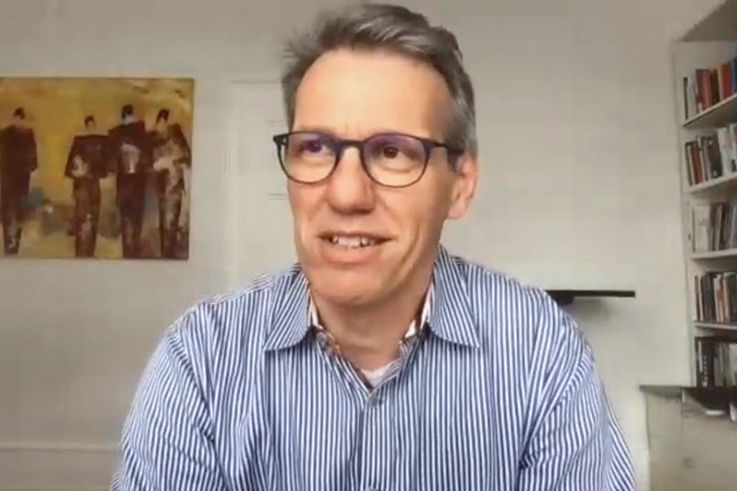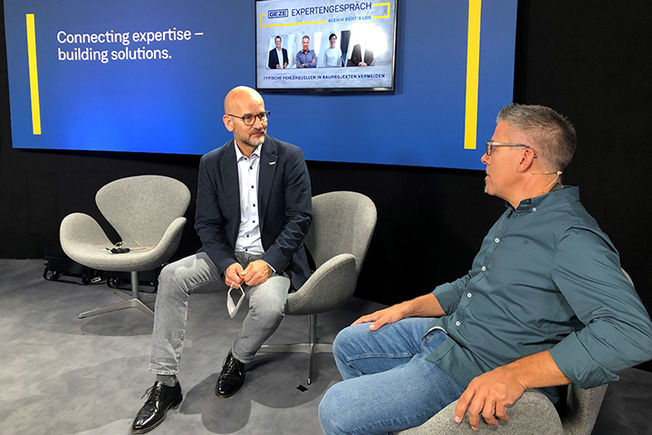How to avoid common sources of errors in construction projects
It is a situation that is likely familiar to many: A building project is in full swing, but more and more problems are coming up everywhere. The wrong materials, incorrect dimensions, and poor communication among those involved. Experts discussed in the new GEZE studio in Leonberg how these kinds of mishaps can be avoided, and why the topic of doors is so challenging for site managers.
Poor communication in construction projects

An expert perspective from the academic side was provided by the head of the Systemic Management research program at the University of St. Gallen, Prof. Thomas Schuhmacher. © GEZE GmbH
Prof. Thomas Schumacher from the University of St. Gallen started off by sketching out the basic problem in construction projects. Everyone involved is looking at the same issue from different perspectives, and each of the participating subsections has a different focus. Josef Faßbender, expert and acknowledged specialist in the area of door technology, confirmed this with practical examples, using photos to show what the results can be: incorrect material installed behind the door (decisive for fire protection), an excessively large gap under the door because the floor was incorrectly installed before the door, and a missing fanlight. The initial conclusion of the discussion was that communication among those involved is essential – from site management to installation and maintenance.
If the left hand doesn’t know what the right hand is doing ...

Roland Joss founded e-tool ag with partners in 2003, a company that plans, coordinates and monitors safety technology subsections. © GEZE GmbH
... then chaos is sure to follow. This is particularly true for door planning. As Roland Joss, expert for safety and specialist door planning projects, explained, this topic “has been on the radar of architects for 5 to 10 years, because complexity in this area has increased exponentially, partially due to the electronic access system”. In this respect, it is important that safety planning be given priority, with fire protection and escape route plans as well as the user concept – and that “traditional door planning” be addressed only afterwards. And how you tell that a door has been planned well? Katrin Höfer, Managing Director of GEZE Service GmbH, had an answer ready to that question: “When all subsections work well together, when the subsection knows in advance what it needs to do so that we as manufacturers can complete installation... And when you are not waiting until you get to the construction site to ask questions like: What exactly are we trying to achieve here?"
Access control, burglary protection, smoke protection, fire protection, escape routes, etc. – as components, doors are highly complex.
Josef Faßbender, expert and specialist in door technologyClear communication for optimal results

Josef Faßbender, publicly appointed and sworn expert for metalworking by the Aachen Chamber of Crafts since 2005. © GEZE GmbH
From door drives to hold-open systems or closing sequence controls – user requirements must be clearly described in advance. Josef Faßbender emphasised that “the precise functional description of a door system” is important, so that the user knows whether it precisely conforms to his requirements. Then the other interfaces, such as walls, ceilings, floors and electrical lines can be addressed to match up with these. “That is why, as we know, this component of the door is one of the most complex” emphasised Faßbender, “with access control, burglary protection, smoke protection, fire protection, escape routes, etc.” To avoid sources of errors, however, everyone involved in the doors subsection must speak the same language.
To ensure success, each of the subsections needs to be interested in what the others are doing, and they need to look beyond their own horizons and beyond the bounds of their own responsibilities.
Roland Joss, expert for safety and technical door planning projectsCooperation and collaboration as the keys to success

Katrin Höfer is with GEZE since 2008, Managing Director of GEZE Service GmbH since 2016. © GEZE GmbH

The experts discussed the challenges of successful construction planning. © GEZE GmbH
Prof. Thomas Schumacher emphasised that different perspectives on the same topic can be enriching. He suggested recognising other perspectives as helpful. To achieve productive results, he also said it is important to see your own area “not only as part of the solution, but also as part of the problem”. When everyone sees themselves as a “lone fighter on the construction site”, as Katrin Höfer explained, communication and coordination between the subsections are almost impossible, resulting in discrepancies and mishaps. If the recess for the door is larger than planned by the door's manufacturer, for instance, this can be an annoying surprise. Cooperation and collaboration are the keys to success – all of the experts agreed on that. “To ensure success, each of the subsections needs to be interested in what the others are doing, and they need to look beyond their own horizons and beyond the bounds of their own responsibilities”,Roland Joss summarised.
Behind the scenes
Here are a few snapshots of the first GEZE expert discussion in our film studio in Leonberg.



